$40bn to save Jakarta: the story of the Great Garuda
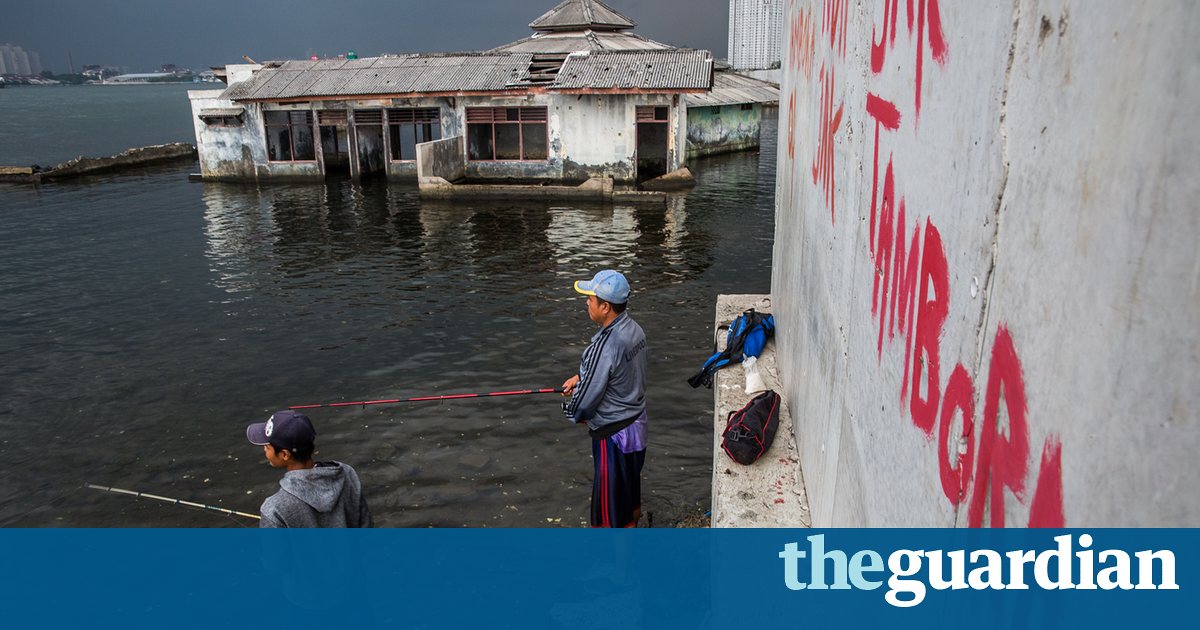
Forget Venice. The fastest-sinking city is the Indonesian capital, parts of which are dropping at 25cm a year. Can an outlandish plan for a giant seawall and luxury waterworld city in the shape of a mythical bird save Jakarta from drowning?

 About this content
About this content With her hand stretched upward, the elderly storekeeper in batik dress and white headscarf indicates the height of the waters that poured into her home in Jakartas great flood of 2007. Sukaesih is a diminutive figure, but she points to a ridge on the doorframe about two metres above the threshold.
The 60-year-old grandmother, who like many Indonesians goes by only one name, lives in the down-at-heel waterfront neighbourhood of Maura Baru. Her front room-turned-store, where she sells soft drinks and the clove kretek cigarettes beloved of locals, looks unassuming, but is at ground zero for the citys battle for survival.
Just across the alleyway is the stone seawall that was reinforced and heightened after 2007, but is already cracking, buckling and leaking. The fortification is all that stands between these homes and the waters of Jakarta Bay, which lap just beneath the rim on the other side. Filthy water already seeps through the cracks continuously, leaving streams of muddy run-off flowing in front of Sukaesihs shop. When tides are high, the water pours over.
We live with this reality every day, Sukaesih says, looking out at the embankment. Water comes in through the wall all the time, and it comes over the top whenever theres a high tide.
The biggest problem, however, is that the seawall itself the only thing protecting Sukaesihs community from inundation is sinking.
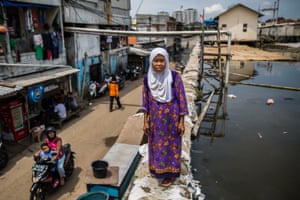
Forget Venice, which is slowly dropping into its watery foundations at an estimated rate of 2mm per year. Thats a drop in the ocean compared to Indonesias capital, particularly its northern belt, where four million people live in neighbourhoods that are now up to four metres below sea level. Areas of north Jakarta, including the seawall designed to protect them, are sinking at an estimated 25cm a year.
I have been here since 1981 but I dont know how long we can stay. The water gets higher every year, Sukaesih says referring to the danger that is, in fact, posed by the ground sinking beneath her feet.
Jakarta is sinking because of subsidence. The city does not pipe in enough drinkable water, so Jakartans rely largely on wells which extract water from shallow aquifers. The result: the land above it collapses.
The problem is exacerbated by the explosion of new apartment blocks, shopping malls and even government offices, which despite official restrictions on groundwater extraction not only draw water from this porous ground but also add to the weight compacting it. The concretisation of Jakarta has also led to increased run-off, making flooding worse while not replenishing the ground water supplies.
As the sinking continues at a rate unparalleled in any other urban area in the world, the danger of a catastrophic flood grows, caused not by devastating seawater surges or storms but by monsoon rain-swollen rivers bursting their banks because gravity no longer helps them flow out into the bay.
There is a desperate need to supply potable water to the city from reservoirs to the east and west. But while plans for pipelines remain in the pipeline, some experts claim Jakarta is careening towards the point of no return.
The city: Two years to save northern Jakarta
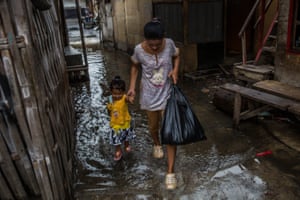
Set in a basin of low-lying plains criss-crossed by 13 rivers, Jakarta home to 10 million, with a total of 30 million living in the sprawl of Greater Jakarta owes its existence to its waterfront location and geography.
The natural harbour was for several centuries an important port for its Hindu and then Muslim rulers, before Dutch settlers seized control and established the trading post of Batavia as capital of their East Indies territories.
The perils of flooding are as old as the city. The Dutch, the masters of such challenges at home, built a network of canals in an attempt to control the flow of waters, but never mastered them. Now, as the city sinks so dramatically, Dutch engineers and businessmen are again offering their proposals to defeat encroaching waters and reclaim land.
We all knew that Jakarta was sinking back in the 90s and indeed earlier, but nobody was that worried or really had any idea of the extent, says JanJaap Brinkman, a hydrologist with the Dutch research institute Deltares, who has spent most of his adult life working on Jakartas watery woes.
Then came the floods in 2007. When we studied the data and looked at the mapping, we discovered the city was sinking not perhaps by a centimetre or so per year, as had previously been thought, but by 5-10cm on average, and much more in places.
With more than 50 people dead and 300,000 forced to evacuate their homes as waters covered more than a third of the city, 2007 was a startling wake-up call. The solution on paper was simple the city must supply clean piped water, and end its dependency on groundwater extraction.
Tokyo did just that in the 1960s after sinking more than four metres during the 20th century. Within a decade, says Brinkman, pointing to graphs on his laptop, that downward trajectory was permanently halted.
But in Jakarta, there has been no significant progress in the nine years after the floods, thanks to a combination of financial restraints, competing infrastructure demands, and the sclerotic impact of the highly decentralised system of government introduced in response to the Suharto dictatorship. Brinkman, his good humour at times tested by this inertia, says there are now only two years left to act, or it will be too late to save northern Jakarta from disaster.
There is another dramatic and controversial plan to save the worlds fastest-sinking city from itself: the so-called Giant Sea Wall and Great Garuda projects.
At the heart of the proposals with an estimated cost of as much as $40 billion is a massive dike arcing 25 miles across Jakarta Bay which would create a vast manmade lagoon, with a new coastal megacity to be built around it on reclaimed land.
The project, officially known as the National Capital Integrated Coastal Development (NCICD) programme, was backed with aid from the Dutch government, embraced by Indonesias president Joko Widodo, a former governor of Jakarta, and is now being championed by a Dutch-led consortium.
The land reclamation dates back to a stalled plan from the President Suharto era to create 17 new islets off the citys coastline. But it has morphed into a much more ambitious concept for a colossal new waterfront city, fanning out from sea wall in the shape of a garuda the mythical bird of Hindu origin that is the countrys national symbol with a multilane ring road for the perennially traffic-clogged capital running along its rim.
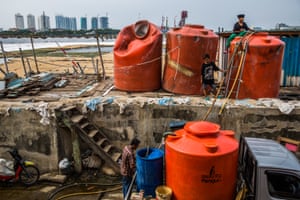
From above, the designers illustrations for the Great Garuda project are redolent of the artificial Palm islands off the shore of Dubai. Its prospective developers also looked closer to home for inspiration, planning to build glitzy skyscrapers, luxury flats, shopping malls and attractions similar to Singapores Sentosa Island.
Champions say the Giant Sea Wall will soon be the only way to save the city from catastrophic floods sweeping across the northern belt of land, with the new islands providing the financing by tapping into the monies of property development tycoons. But the schemes are now mired in lawsuits, scandals and moral controversy particularly over the mass evictions of traditional fishing villages and waterfront communities, many of which have been bulldozed flat.
Critics a broad coalition of Indonesian scientists, land activists and local residents say it is an outlandish and unnecessary project that would wreak environmental and social disaster. They argue the lives of traditional fishing communities are being destroyed as mass evictions are imposed, with whole neighbourhoods razed and residents relocated more than 10 miles away.
They also claim that walling off the bay would turn it into a septic lagoon of trapped freshwater. With little sewage treatment for the river water pouring into the bay, this corporate attempt to sanitise Jakartas waterfront could end up having exactly the opposite effect.
The rivers: Everyone agrees we need to do this now
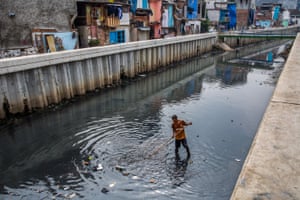
What is not in dispute is the need for urgent action. Just in front of the old fortification at Maura Baru, thick new pilings are being driven into the seafloor to provide a higher and stronger defence against the waters. Few people object to this, the start of Phase A of NCICD programme.
This is the no regrets stage, as everyone agrees that we need to do this now, says Tuty Kusumawati, head of the Jakarta planning department, as she pores over maps and diagrams of the waterfront.
To deal with the freshwater flooding, heavily polluted and rubbish-strewn rivers are being widened, dredged, cleaned and protected with new concrete barriers, in initiatives ordered by Basuki Tjahaja Purnama, the governor known to all by his nickname, Ahok.
For the smaller rivers that have already sunk too far to flow out to sea, pumping stations and polders are being built, with reservoirs to hold water at times of heavy rain and flooding. But some experts say there arent large enough pumps or sufficient land available to deal with the larger rivers hence the call for more dramatic intervention.
When presented with the proposal for the Giant Sea Wall, the Indonesian government asked the Dutch consultants to deliver a more ambitious concept to accompany it. From that request, the design for the Great Garuda was born.
The Netherlands is an undisputed bastion of international expertise on fighting the seas and land reclamation. But in its former colony, some critics have expressed scepticism about the motives of the Dutch government-funded consultants and businessmen proposing such a colossal scheme.
Victor Coenen, the project manager for Witteveen+Bos, the engineering consultancy that heads the Giant Sea Wall consortium, shrugs off the criticism. Fine, if they dont want our help, then we can go elsewhere, he says. But it is the Indonesian government that has asked for Dutch assistance to deal with the flooding, and it is Dutch government money that is helping.
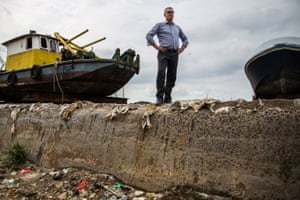
This weeks visit to Indonesia by a high-profile Dutch trade mission, headed by the prime minister, Mark Rutte, is giving fresh impetus to the debate. The Save the Jakarta Bay Coalition, an alliance of groups opposed to the scheme, has written to Rutte spelling outs their fears and criticisms.
The Dutch are well known for their flood mitigation measures, the letter notes. These measures adopt a complex approach, which follows the principles of environmental and social protection and good governance. [But] what is happening in Indonesia is entirely the opposite. We are deeply concerned about the livelihood loss and infringement of human rights, as well as irreparable environmental damage, caused by the project.
We therefore stress that, if your government and the Indonesian government insist on building the NCICD, tens of thousands of people connected to small-scale fisheries will lose their livelihood.
The widening and fortification of the citys rivers has already seen the eviction of thousands from kampung communities that have sprung up along its rivers and reservoirs. Bulldozers are often deployed with just a few days notice and residents ordered to move to new concrete public housing, often miles away from the waterfront where they work.
According to Brinkman, however, There are only two options, retreat or advance. We either abandon and evacuate north Jakarta, which is a non-starter, or we advance out into the bay with the seawall.
The bay: creating a septic lagoon?
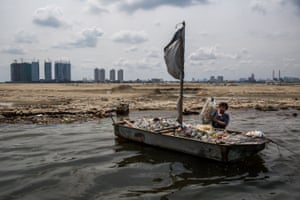
At Maura Baura, Coenen outlines the arguments for NCICDs Phase B the Giant Sea Wall as he conducts a tour of the current fortifications.
In the old days, the water ran out to sea, he says. Now water collects in the city from several of these rivers. It cant get out so we pump it out. But for the large rivers, we need ever-higher riverbanks and ever-bigger pumping stations and storage lakes.
We cant build up riverbanks that are five or seven metres above the neighbouring communities, and there is not enough space onshore for the pumping lakes. So were proposing the Giant Sea Wall to create what is effectively a giant pumping lake offshore. Then we can then lower the water level, so those rivers can flow again.
But this part of the project has been met with scepticism by some prominent Indonesian scientists. Alan Koropitan, professor of oceanography at Bogor Agricultural University, contends the solution for Jakarta Bay is restoration, not reclamation.
He says building an outer sea wall and manmade islands would create greater pollution and sedimentation as waters are trapped inside the dike, rather than being flushed out to sea.
If, instead, we can restore the bay and its polluted waters, that would mean something good for civilisation in Indonesia. I believe that a new economy will come from that in tourism, aquaculture and fisheries.
Muslim Muin, head of coastal engineering research at the Bandung Institute of Technology, is equally unimpressed with the multibillion-dollar proposal. If the Giant Sea Wall is built, it would inflict huge construction and operational costs and serious environmental costs. Even worse, it would exacerbate Jakartas flood risk.
By building the reservoir, the circulation of water will drastically decrease and even reach a point when it becomes stagnant water. The natural cleansing process would no longer happen, he adds, citing the water-borne malarial epidemics of Dutch days.
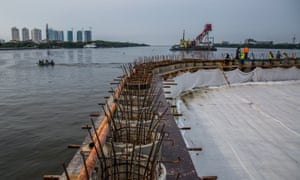
Coenen too acknowledges the environmental dangers of a septic lagoon that could be created by walling off the bay. But he contends that the wall should be accompanied by measures such as water sanitation. The point really is that very soon, we will have no choice, he adds.
It is not just an environmental controversy, however. The Giant Sea Wall plans have become entwined with ever-more ambitious, and contentious, schemes for a radical facelift for the whole waterfront.
The residential move south away from Jakartas coast began with Dutch colonialists in the 19th century, who preferred to live in greener areas less prone to disease and flooding. It was a trend that continued after independence in 1945, with most Indonesians choosing to live in what is now South, East and West Jakarta.
That left behind a coastline dominated by the citys industrial port and harbour, and populated by fishermens slum dwellings. The notable exception was the Indonesian-Chinese community that plays a powerful role in the countrys business world, including property development.
The citys ethnic Chinese have long lived near the bay and many influential families are based there in exclusive gated communities and nautical-themed luxury apartment blocks bearing names such as Regatta and Green City.
Talk of a new waterfront city of 17 manmade islets, jutting up to two miles out into the bay, began in the mid-1990s. The project stalled after the Asian economic crisis but was later revived with an added twist it could be deployed to garner private funding for the NCICD in a country where government coffers are always stretched.
Huge industrial dredgers moved into the bay to discharge their loads and start creating the first four islands in 2013, but that work was brought to a jarring halt last April. A moratorium was declared in the wake of a high-profile and ongoingcorruption case involving a company executive from one of the showpiece developments bribing a local parliamentarian over zoning laws.
The prosecutions exposed murky financial ties between the developers and Jakarta city budgets. The government said the reclamation would start again in September, but as yet there has been no more work on the scheme. So the four part-built islands sit in Jakarta Bay, unfinished and off-limits.
The islands: high-rises, gated compounds and marinas
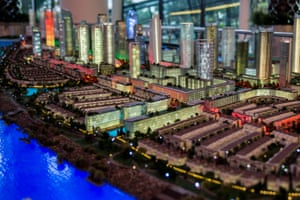
Visitors entering the air-conditioned oasis of the Riverwalk Bay shopping mall, at the base of the Green City complex in the waterfront Pluit district, can cast their eye over a model (pictured above) of how the NCICDs Island G marketed as Pluit City looks in the designers eyes. It is a futuristic extravaganza of gleaming modernist high-rises, gated villa compounds and yacht marinas.
A security guard hovers to enforce the no photographs rule, so for a close-up view of Island G, it is necessary to head out into the bay with Suhali bin Urip, a local fisherman who has worked these waters for 30 years.
The 58-year-old Suhali his face creased beyond his years by decades at sea under the tropical sun is a prominent voice in the no reclamation campaign.
Were the ones who live and work here, but nobody is consulting us about our futures, he says. The elite, the politicians and the rich, are making the decisions, but they dont care about us or understand us.
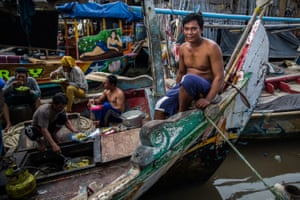
Suhali lives with his family in the fishing village of Muara Angke, where men make on average $25 to $40 a month working on boats that are now forced to venture ever-further out to sea in search of a catch.
Shanty dwellings of plywood, breeze blocks and corrugated metal, often lashed together by rope or metal fixtures furnished from scrap, are precariously balanced on wooden stilts over a waterfront that serves as toilet and rubbish dump.
Suhalis small wooden skiff, its paint peeling and decking loose, is tethered at the end of a rickety path of bamboo poles and old door frames. He yanks a few times on the starting cord of the outboard engine, and we sputter off into the bay towards our target our progress in these sensitive waters observed by a police motorboat.
The future Pluit City soon comes into view, although for now the islet is no more than a low spit of reclaimed sand sitting a few feet above water level, with the Regatta and Gr
Read more: https://www.theguardian.com/cities/2016/nov/22/jakarta-great-garuda-seawall-sinking